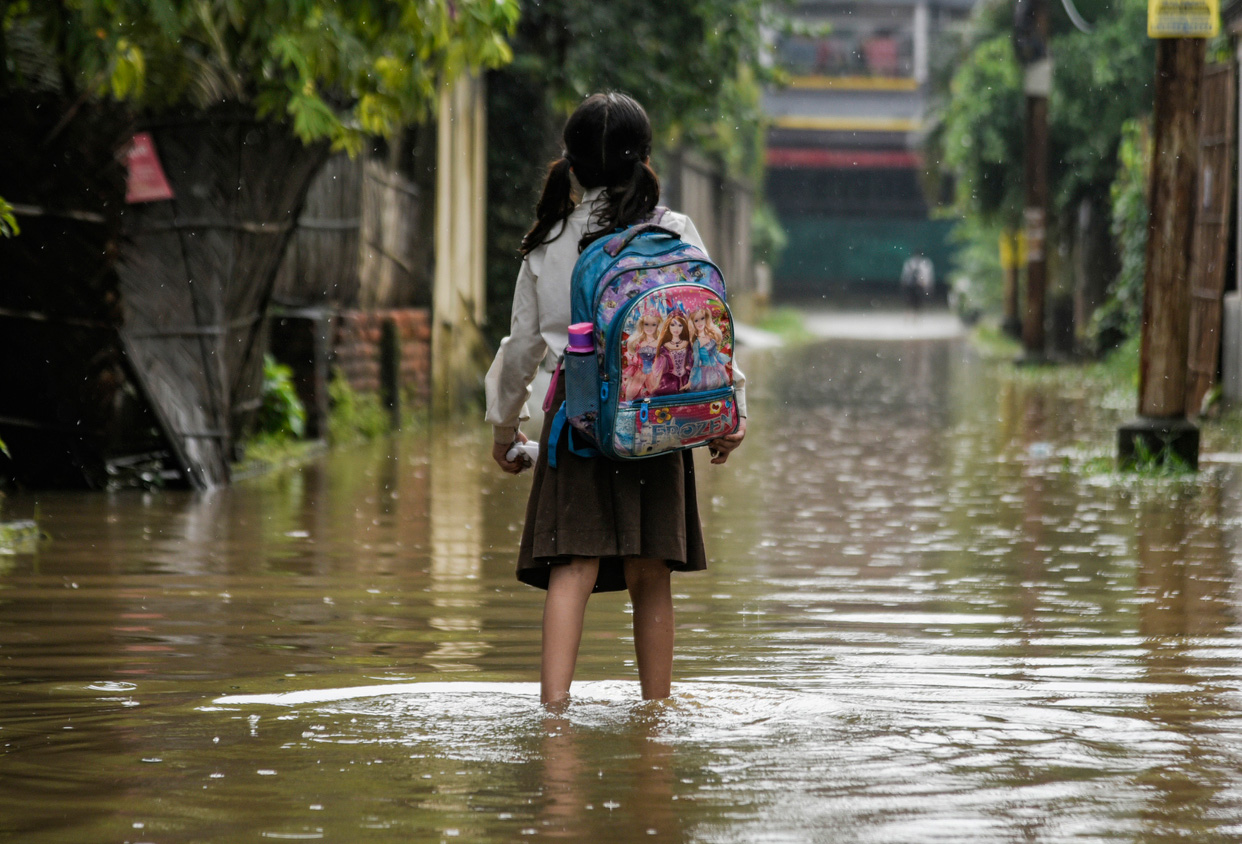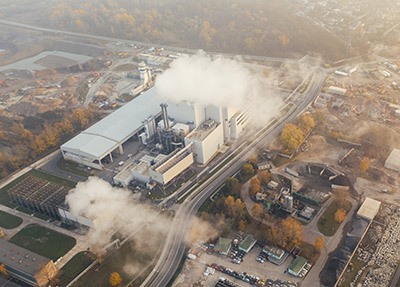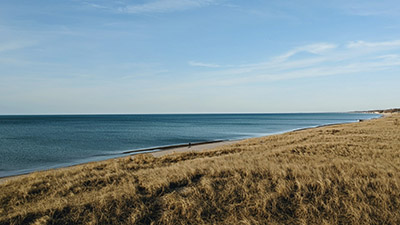Manifesting, Measuring, and Mitigating Climate Change
IPR researchers focus on climate change’s human costs and climate inequality
Get all our news
I see climate change as inextricably linked to inequality. On a global scale, many of the poorest countries will experience the most dramatic climatic shocks and will be ill-equipped to deal with the ramifications of climate change. ”
Julia Behrman
IPR sociologist

It’s April, another Earth Day has arrived, with another alarming report on the state of our climate and our planet. In March, the United Nations’ Intergovernmental Panel on Climate Change (IPCC) announced that humans must cut greenhouse gas emissions almost in half by 2030 or face catastrophic effects of global warming. These include drastic sea level rise and climate extremes that harm nature and peoples’ lives and livelihoods, disproportionately affecting the world’s poorest.
While scientists at Northwestern and other institutions are working on the processes of climate change, IPR researchers are approaching it from an equally important perspective, that of the social sciences. Their questions tackle deep-seated social and political issues, such as: How does climate change affect how people live, in the U.S. and across the globe? How does it widen inequities among people? How do we measure and address its impacts? Which policies will prove more effective in healing the planet and bettering its people’s health?
The Impact of Climate Change on People’s Lives
IPR anthropologist Sera Young’s research focuses on how people deal with water insecurity. Where does climate change fit in?
“I always say water insecurity is climate change made manifest, or if climate change is the shark, water is the teeth,” she replied.
Young explains that climate change “made manifest” may mean too much—or too little—water, or water of unacceptable quality. Too much rain causes flooding, and water going where it should not, contaminating water with sewage, for example. Saltwater intrusion, another consequence of climate change, means fresh water becomes contaminated with seawater. Drought from rising temperatures can results in too little water for drinking, cooking, and bathing.
In a recent and widely covered study published in The Lancet Planetary Health, Young and her colleagues assessed individuals’ experiences of water insecurity. Her team surveyed over 45,500 adults in 31 low- and middle-income countries across the globe. They find that roughly 14% —or about 436 million of the 3 billion adults represented by the survey sample—experienced water insecurity. For example, nearly 64% of Cameroon’s people suffered water insecurity, while over sub-Saharan Africa as a whole, the part of the world with the highest levels of water insecurity, more than one-third (36%) of the population experienced it.
A metric that asks people if they worry about not having enough water or must change what they eat because of floods or droughts stands in contrast to previous measures. Prior to Young and her collaborators’ development of the Individual Water Insecurity Experiences (IWISE) and Household Water Insecurity Experiences (HWISE) scales, water insecurity was measured based on observable phenomena, like the physical availability of water, or drinking water infrastructure. These indicators obscured differences in availability and access within groups of people. Furthermore, the resulting water statistics, such as cubic meter per capita, are difficult to understand intuitively.
In contrast, understanding the proportion of the population who has been angry about their water situation or unable to bathe because of problems with water is much more intuitive. The WISE scales, therefore, bring a badly needed “human voice” to the water sector.
“We are making problems with water visible by counting experiences. We're counting experiences at a higher resolution than is normally captured,” Young said. “We're measuring them at the individual level, which means that we can see disparities in use by gender or age or ethnicity or physical ability, and we're measuring them more holistically.”
Young’s research shines a light on the real impacts of climate change on ordinary people’s lives. Similarly, IPR sociologist Julia Behrman investigates how climate change may mean profound change in important life decisions.
 While many think about how climate change affects people’s livelihoods, Behrman and her co-author, Liliana Andriano of the University of Oxford, go a step further in thinking about its influence on key transitions in young people's lives. They examine how extreme drought and rainfall in the southeastern African nation of Malawi affected when young women married, began living with a partner, had their first child, and even how it could influence a woman’s decision to exchange sex for goods and cash.
While many think about how climate change affects people’s livelihoods, Behrman and her co-author, Liliana Andriano of the University of Oxford, go a step further in thinking about its influence on key transitions in young people's lives. They examine how extreme drought and rainfall in the southeastern African nation of Malawi affected when young women married, began living with a partner, had their first child, and even how it could influence a woman’s decision to exchange sex for goods and cash.
The researchers demonstrate that adolescent girls who experienced droughts during the November to April growing season married or began living with a partner earlier and also began having children earlier. Malawian women under more normal circumstances marry and have children quite young, at about 18- or 19-years old, and the finding implies that financial necessity pushed families to marry off their women at these young ages to have fewer people to feed or for the exchange of goods marriage brings. This is a “striking finding,” they write and exemplifies how poor countries—and the poorest people in them—are more vulnerable to the weather extremes that climate change brings.
“I see climate change as inextricably linked to inequality,” Behrman said. “On a global scale, many of the poorest countries will experience the most dramatic climatic shocks and will be ill-equipped to deal with the ramifications of climate change. At the same time, climate change has the potential to exacerbate inequality within poor settings in the Global South that are also extremely unequal.”
Behrman is also concerned about how climate shocks “will exacerbate inequalities in schooling and learning in sub-Saharan Africa, a region that is already characterized by great inequality in attainment and learning.” She hopes to launch research into the effects of climate change on schooling in the region, which would provide policy directions for improving education and mitigating inequalities.
“I see climate change as inextricably linked to inequality and an important component of my own work is better understanding the drivers of inequality so that we can build effective policy solutions,” she explained.
Addressing Climate Change
An important tool to reduce greenhouse gas emissions and reduce global warming is the carbon tax. Governments use it to tax those who create emissions, and businesses and consumers may minimize their tax by switching fuels or using new technologies for their needs.
IPR sociologist Monica Prasad studies taxation, including the workings of the carbon tax and of the little-known but similar instrument, public benefit funds. Her research shows that carbon taxes may be more promising than their negative reputation in the U.S. suggests because their benefits are underestimated. They have worked best, she notes, when taxed businesses can turn to alternative fuel sources.
“The problem with a policy of ‘carbon tax’ is that it tells you what you will lose but doesn't tell you what you will gain,” Prasad explained. “If you start by telling people what the service is that the tax is funding—if you call the policy by the name of that service, ‘renewable energy scheme’ or ‘sustainability grants’ or whatever—the focus can be on that. I don’t think we would have gotten Social Security or Medicare by telling people only that we will implement a ‘payroll tax,’ but we won’t tell you what you’re going to get for it!”
The public benefit funds, currently in place in 22 states plus the District of Columbia and Puerto Rico, work similarly to carbon taxes without the word “tax.” The funds are a policy that adds a charge per kilowatt-hour of energy consumed to the electricity bills of businesses and consumers. They are usually called a “system benefit charge” or “public benefit charge.”
Carbon taxes are applied to emissions. Public benefit funds are assessed at an earlier point—when electricity  is consumed. This is a key difference, Prasad points out, because it gives consumers an incentive to reduce their use of electricity—one that a carbon tax does not provide.
is consumed. This is a key difference, Prasad points out, because it gives consumers an incentive to reduce their use of electricity—one that a carbon tax does not provide.
In PLOS Climate, Prasad examines the effectiveness of public benefit funds and how the policy differs among the states that employ it. Public benefit funds have received little scholarly or journalistic attention until now.
“I think they are so small that they have escaped attention, and it may be that the intent has been to escape attention by not calling them ‘taxes,’” she said.
Prasad calculates that public benefit funds have reduced carbon emissions, and her research shows that they are politically viable in U.S. states, even quite conservative ones. Unlike carbon taxes, which if effective would produce less revenue over time as emissions were reduced, public benefit funds might even increase revenue as alternative fuel sources enabled electricity use that produced fewer emissions.
Both public benefit funds and carbon taxes are valuable tools for policymakers, Prasad says. Although a federal policy implementing public benefit funds seems politically infeasible, what is feasible, she suggests, is for states without them to adopt them. Additionally, states with such funds could raise their fee rates slightly. As to carbon taxes, Prasad reminds policymakers that they work best when taxed businesses have alternative fuel sources they can shift to.
Tackling Climate Justice
Shifting and widening our perspective on climate change is a new and better way to address it, according to a group of Native American and Indigenous scholars and colleagues, including IPR’s Kimberly Marion Suiseeya and Beth Redbird. Suiseeya, a political scientist, and Redbird, a sociologist, are also fellows with Northwestern’s Center for Native American and Indigenous Research.
In a special volume of the Annals of the American Academy of Political and Social Science, edited by IPR political scientist James Druckman, Suiseeya, Redbird, and their colleagues propose focusing on climate justice and centering Indigenous experience and knowledge in overcoming the threats of climate change. They contrast knowledge produced by the scientific method with traditional knowledge, which is produced through “direct application and experience,” learned from elders and life. Both systems of knowledge are needed to effectively address climate change, they argue.
“Traditional knowledge draws on generations of ongoing, empirical observations of the complex interdependencies of our world, revealing insights into how climate change impacts not only parts of the system, but the system as a whole—phenomena that the scientific method rarely, if ever, captures,” Suiseeya said. “Science is fairly narrow, time bound, and often not situated in place—it lacks the depth of observation and the ability to see connections that experiential knowledge can reveal.”
The researchers center their analysis on traditional knowledge found in the Upper Great Lakes, where the Ojibwe people have relied on manoomin—or wild rice—for generations. Like other Indigenous communities, the Ojibwe Nations are especially vulnerable to climate change’s effects on their food, water, and culture.
 If manoomin were to disappear due to habitat loss and degraded water quality, the researchers write, it would “precipitate the displacement and ultimate decline of Ojibwe identities, lifeways, ways of being, and ways of knowing, the very existence and practices that are spiritually rooted in manoomin.” Such a catastrophe exemplifies climate injustice, the disproportionate suffering of climate change.
If manoomin were to disappear due to habitat loss and degraded water quality, the researchers write, it would “precipitate the displacement and ultimate decline of Ojibwe identities, lifeways, ways of being, and ways of knowing, the very existence and practices that are spiritually rooted in manoomin.” Such a catastrophe exemplifies climate injustice, the disproportionate suffering of climate change.
According to Ojibwe traditional knowledge, climate change is a problem of the eroded relationship between humans and “older-than-human relatives”—the physical world, the plant world, and the animal world. It is also a problem of injustice.
“When we omit and dismiss traditional knowledge from climate change discussions, we limit our understanding of climate change, which narrows the range of solutions we might consider,” Suiseeya explained. “Critically, this omission exacerbates climate injustices by further undermining Indigenous Peoples’ rights to self-determination.”
Despite their deep experiential knowledge of manoomin, Ojibwe people are frustrated by scientists and policymakers’ lack of respect. Their ways of knowing need to be studied, respected, and included in policymaking to combat climate change, the authors urge.
“Dismissing Indigenous knowledge is a symptom of the core issue of not respecting sovereignty and treaty rights,” Suiseeya stated.
Suiseeya and her colleagues have taken an important step towards enacting their goal of bringing together scientific and traditional knowledge with a new five-year program supported by the National Science Foundation. “Strengthening Resilience of Manoomin, the Sentinel Species of the Great Lakes, with Data-Science-Supported, Seventh Generation Stewardship” will model inclusion of strategies based on Indigenous traditional knowledge of manoomin to increase the participation of Indigenous people of the Great Lakes in collaborative scientific research.
“Science that is informed or guided by traditional knowledge frameworks like Ojibwe knowledge is likely to have a much greater impact on solving big, complex problems,” Suiseeya said.
Reaching Policymakers with Evidence-Based Solutions
In addition to the IPR experts above, additional colleagues are offering tools and models to better understand the scope of the problem and what can be done. Economist Charles Manski tackles climate policy modeling despite the many unknowns—uncertainty—to better guide policies to reduce greenhouse gas emissions. Mar Reguant, also an economist, studies the regulation of European electricity markets and proposes policies to aggressively counter climate change. According to law professor David Dana, current federal disaster aid policies exacerbate the inequalities between richer and poorer places and people in the U.S.—another example of climate injustice. He argues that policy and administrative decisions include equality concerns. Druckman and political scientist Mary McGrath study issues of political communication and partisanship about climate change and find that Democrats and Republicans, through different messaging, may be brought closer together in opinion.
Whether it’s measuring demographic changes and water experiences, modeling greenhouse gas emissions, assessing tax and legal structures, mining public opinion, or incorporating Indigenous traditional knowledge, IPR researchers are providing rigorous evidence for scalable policy solutions and urging us to refocus these debates—with an emphasis on better understanding how climate change amplifies and propels inequality. Their work also documents the human suffering that climate change brings.
Will policymakers respond?
“Oh, Lord,” Young exclaimed, “I bloody hope they listen!”
Julia Behrman is assistant professor of sociology and an IPR fellow. Monica Prasad is professor of sociology and an IPR fellow. Kimberly Marion Suiseeya is assistant professor of political science and the Environmental Policy and Culture program and an IPR associate. Sera Young is associate professor of anthropology and global health and an IPR fellow.
Photo credits: iStock
Published: April 24, 2023.


